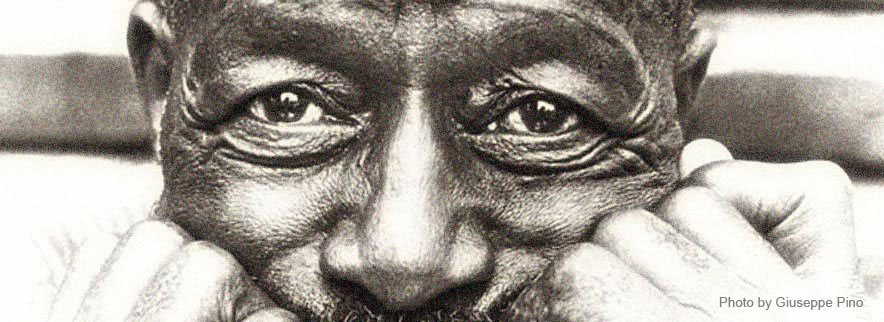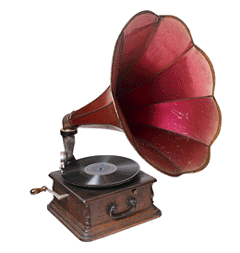The title is provocative, yet there are arguments that the promotion and distribution of blues was part of the marketing strategy that helped the record industry to survive in the twenties. The twenties were a decade of rapid socio-technological change and, apart from a short economic recession in the beginning of the twenties, and a small one in 1924, it was a period of economic boom. It can be compared to some extent to the technological bubble that we experienced in our western world at the end of the 20th century. Communication means grew rapidly (roads, cars, …). Also, in the beginning of the twenties, the radio started conquering the world. And that is exactly what made the record companies shiver and forced them to look for means of competing with this new way of distributing music.
Music distribution by means of records was still a relatively new medium in the beginning of the twenties. It was only in 1877 that Edison presented his phonograph : a wax-coated cylinder that reproduced the sound that was recorded through a huge horn transforming the waves in the air into small ‘ups’ and ‘downs’ on the wax and tin foil. Reproduction on a mass scale of sound recorded in this way was no option. The cylinder on which the sound was recorded was also the cylinder that had to reproduce the sound. Though the use of different waxes and different types of needles gradually improved the quality of the sound and increased the number of possible replays, it was only when the German immigrant Berliner, some ten years later, introduced the flat disc – which recorded and reproduced the sound in an horizontal way by means of grooves in stead of ‘ups’ and ‘downs’ – that mass reproduction was on the horizon. These flat discs (gramophones) could be copied many times, though there were still serious technical limitations and artists were sometimes forced to record the same song over and over again.
In any case, the record industry was launched at the start of the 20th century. Sheet music which until then was the sole ‘registered’ channel for the distribution of music, had a competitor. Commercial recordings emerged as the 20th century kicked off. In 1902 we had already the first million seller (Italian tenor Caruso). Before 1916 more than 70 record companies were founded. In 1921 record sales in the US peaked at more than 100 million $
The recording and playback process were mechanical. It was only in 1925 that the Victor Talking Machine Company introduced the electrical recording and playback process (orthophonic sound), transforming the sound waves into electrical current which could be amplified. This was then considered as a huge revolution which made the head lines of the news papers, much on the same level as the CD compared to vinyl when it was introduced in 1984. In 1928, the mechanical procedure using cylinders lost its battle with the flat disc.
Victor put on the market both electrical and mechanical devices (the latter, called Victrolas, were much less expensive and were meant for the large (white and black) market. The device was an enormous success and quickly became a symbol of social status. It was also very popular amongst the black population.
This search for innovation was an economic necessity as more and more households acquired a radio, which brought the record producing companies into financial difficulties.
Of course, record players are of little use when there are no records to play. The huge success of Mamie Smith’s ‘Crazy Blues’ in 1920, showed the record companies that there was a market. The success that vaudeville blues had in the North only confirmed this conviction. The blacks in the North that bought this music also had their memories of the country blues that lived in the South. The record companies started sending talent scouts to the South looking everywhere for musicians to be discovered. The (country) blues was a market to be explored which could help business figures rise.
Many of the local talents were songsters and entertainers with a broad repertoire, but were ‘forced’ to narrow down their singing and playing to their blues repertoire, since this was the product that was being marketed. This process was thus clearly ambivalent: it helped us to have recorded sources of the music that lived in the country, but at the same time, it meant a narrowing of the repertoire of most of the talented musicians. Blues was not the only style they practiced, they would bring whatever the public liked to earn the butter on their bread. However, it was not put on record.
The radio was a medium of the white population; blues was played life or circulated on records. The record companies made great efforts to go into the field to find black artists who were recorded in studio’s which were set up where ever possible. In his 1959-“Country Blues” book, Samuel Charters tells the story of the difficulties which had to be faced in those early days: studios set up in churches or hotels had to be moved in a hurry when the local white population showed in a more than verbal way that they didn’t like the blacks to be seen around. In the Southern states, the early technology of microphones did’nt always stands the hot heavy air. What an heroic times !
Ralph Peer cannot go unnoticed for the prominent role he played in recording the early blues in the field. Though he became most famous for launching the country music careers of the Carter family and Jimmy Rodgers, and also had a keen nose for the talent of Louis Armstrong, he also did a fabulous job for the country blues. In the first place however, the man got rich, keenly managing the copyrights.
It is strange to see that at the same time that record companies were looking for black blues talent, there was also a scholarly interest in blues from an ethno-musicological perspective. The Library of Congress showed already its interest in the local music, though not specifically for the blues. There was however no interconnection between both, the former not being aware of what the latter registered. But that is a different story on which I would like to blog later on.
I hope I have made my point that blues was in the twenties clearly a marketing product that helped the record companies survive and compete with the popular and new medium called radio.
The evolution of blues (and music in general) cannot be seen without taking into consideration the technological and economical context.



You have brought up a very good details , thankyou for the post. eeceeddkdbagkeec
I’m really enjoying the themedesign of your website. Do you ever run into any internet browser compatibility issues? A handful of my blog audience have complained about my site not operating correctly in Explorer but looks great in Firefox. Do you have any solutions to help fix this problem? cddgaededdgfdedd
Very neat article post.Much thanks again. Much obliged. dcbkefaedebbgbef
interessant om lezen!
boeiend verteld… kijk al uit naar vervolg…
Chris